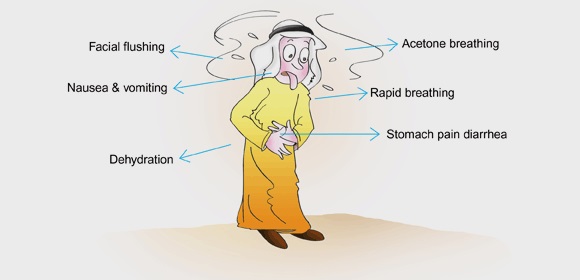The human body will produce more insulin when being sick as a reaction to defend against sickness, as the body needs more energy to fight the disease. So, blood sugar level is expected to raise to higher level.
This increase in the fasting blood sugar may occure for any one, however, it may cause a problem to patients with type 1 diabetes as they may develop Diabetic Ketoacidosis.
It is a trial including :
Ketoacidotic bodies in the blood or urine is an indicator of acute deficiency of insulin and its unability to deal with high blood sugar level. In such case, the body will try to get its needs of energy by destroying fats, with consequent production of ketoacidotic bodies and blood acidosis.

Because if it is not managed properly by insulin and fluids the patient will get severe complications such as electrolyte imbalance, and subsequent imbalance, and subsequent effects of the body organs.
Recommendations for prevention of DKA and maintaining blood sugar level in cases os sickness.
If you suffers from symptoms of sickness such as runing nose, cough, high tempreture, or symptoms of inflamation you must do the following :
Insulin extra doses (every 4 hours)
When ketones are absent and the blood glucose level is more than 8 Take an extra dose of insulin of 10% of the total units of insulin per day (ie if you take 100 units a day, take 10 extra units).
| The 10% extra dose | When the ketones level is (+1) |
| Take an extra dose of insulin of 20% of the total units of insulin per day | When the ketones level is (+2)or (+3) |
| Seek medical advice immediately | If ketones continue to appear in blood or urine despite taking extra insulin doses: |
| One cup of milk | A small cup of unsweetened fruit juice |
| one scope of ice cream | Two tablespoons of jelly |
| A small packet of yogurt | ½ small packet of fruit yogurt |
| One cup of soup | 150 ml Pepsi or Coca-Cola (regular, not diet) |
| Water | Diet Peps |
| Coca-Cola Diet | Seven Up Diet |
Add the numbers of all units of all types of insulin you take a day to determine the total insulin units: for example: If you take 10 units Actrapid before breakfast, , 10 units Actrapid before lunch, 10 units Actrapid before dinner and 30 units Lantos at bed time: -> the total insulin dose is: 60 units per day.
10% of the total insulin units = 6 units.
20% of the total insulin units = 12 units.
| The 10% extra dose | The total insulin units per day |
|---|---|
| 4 units | 40 units |
| 5 units | 50 units |
| 6 units | 60 units |
| 7 units | 70 units |
| 8 units | 80 units |
| 9 units | 90 units |
| 10 units | 100 units |
| The 20% extra dose | The total insulin units per day |
|---|---|
| 8 units | 40 units |
| 10 units | 50 units |
| 12 units | 60 units |
| 14 units | 70 units |
| 16 units | 80 units |
| 18 units | 90 units |
| 20 units | 100 units |
Keep up on our always evolving product features and technology. Enter your e-mail and subscribe to our newsletter.